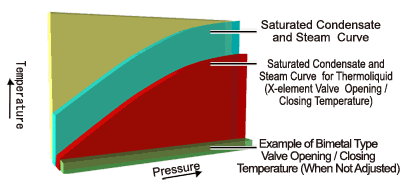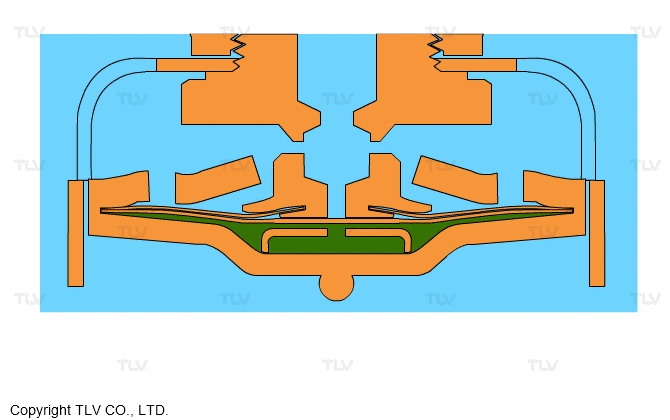- Home
- Steam Resources
- Steam Theory
- Air Vents for Steam
Basics of Steam
Air Vents for Steam
In the article Removing Air from Steam Equipment, discussion mostly revolved around the density of air and steam, as well as how system configuration can influence the position of air vents. The following article will focus on balanced pressure air vents for steam systems.
How Hot Air is Removed from Steam
Balance pressure type air vents are usually recommended for removing air in steam systems. Bimetal type air vents also exist, however these are not recommended for removing hot air from steam systems because the valve opening temperature is more or less fixed. This is different from the valve on balanced pressure type air vents, which opens at a temperature that is a certain number of degrees lower than the saturation temperature of steam. Hot air is therefore discharged at all times regardless of fluctuations in steam pressure.
Balanced Pressure Type (X-element) Air Vents
| Balanced Pressure Type (X-element) Air Vents Graph |
|---|
|
|
Balance pressure air vents feature an element which usually contains an alcohol based mixture. The mixture has been carefully selected to boil at a specific temperature below the boiling point of water. When the temperature approaches the boiling point of water at any pressure, the mixture begins to boil which generates a vapor pressure within the element that causes it to expand, pushing the valve onto its seat and closing the air vent. This type of mechanism quickly responds to differences in temperature, virtually eliminating steam blowing.
| X-element Mechanism |
|---|
|
|
| The X-element is a multi-diaphragm valve filled with a thermoliquid which opens and closes at a temperature below the boiling point of water, allowing the discharge or air or other non-condensable gases. |
| Operation of Air Vent for Steam (LA21) |
|---|
|
|
| At equipment start-up, the X-element valve is in the open position and large quantities of air are quickly discharged, thereby greatly reducing the time taken for steam to flow into the equipment. When the inflow of steam begins, the X-element valve immediately closes. The valve remains closed as long as the temperature around it is near saturation temperature. As the inflow of air causes the temperature to drop, the valve once again opens and the air is rapidly discharged. |
Removing hot air and other gases in equipment is just as important during operation as at start-up. For example, carbon dioxide or other non-condensable gases can be generated while equipment is operating normally due to insufficient treatment of the boiler feed water. Also, residual air inside equipment can be heated by the steam to high temperatures and interfere with heat transfer. If the air and/or non-condensable gases are not completely removed, the efficiency of the steam process can be severely impaired. Air venting should thus be ensured throughout start-up and during regular operation.
Air vents are particularly important when equipment configuration causes air build-up or when the capacity of the air venting function of a steam trap is insufficient (i.e. usually during start-up). When selecting an air vent for steam, the balanced pressure type of air vents are recommended over the bimetal type, and should be fitted in collection areas where air will be pushed on start-up.



